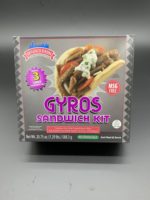Convenience, better-for-you, premium/indulgent and multicultural/global interests continue to drive growth in the refrigerated and frozen foods sector. Taste has a great impact on 90% of food and beverage purchases followed by price (73%), healthfulness (71%, up 9% vs. 2013), convenience (51%, down 5%) and sustainability (38%, down 20% vs. 2011), according to the “2014 Food & Health Survey,” produced by the International Food Information Council Foundation (IFIC), Washington, D.C.
Gourmet everyday
The “2014 New Product Pacesetters” report, put together by Chicago-based Information Resources, Inc. (IRI), says that eight in 10 of the best-selling new foods and drinks launched in 2013 touted a distinctive/new flavor claim followed by ready-to-use/on-the-go (52%), bite-sized/hand-held (41%), easy/microwave prep (39%), kid-targeted (23%) and a different texture claim (21%).
In 2013, 42% of all adult eating occasions and 33% of snacking alone occasions involved a more sophisticated culinary food experience, according to the Compass Database by Hartman Group, Bellevue, Wash.
Meanwhile, the Specialty Foods Association, New York, reported that 74% (or 225 million consumers) purchased gourmet foods last year—60% for everyday meals and 36% for snacks.
In early 2014, 55% of consumers ate Italian foods prepared at home either made from scratch or from a packaged food, followed by Mexican (51%), Chinese (28%), Mediterranean or Cajun (20%), Spanish, not Mexican (18%), Middle Eastern or Japanese (17%), Indian or Thai (13%), Greek (11%) and Korean (9%), according to “2014 Ethnic Foods - U.S,” produced by Chicago-based Mintel.
Consumers are most interested in savory, especially grilled, spicy and smoky flavors, followed by tangy, herbal and fruity options. New/unique flavors are less likely to lure consumers vs. two years ago with hot and spicy, bolder and coupled flavors, according to “2013 Flavor Trend Report” from Technomic, Chicago.
Nearly half (46%) of all adult eating occasions are alone; 35% of these involve a more upscale culinary experience. Hartman Group also observed that when adults eat alone, they’re more likely to opt for fresh vs. frozen meals.
Family meal time may be a thing of the past
It’s time to reconsider “family meal” positionings because 78% of family eating occasions involve adult family members only, while 28% include kids, per Hartman Group. And, with empty nesters and America’s 98 million singles being the Top 2 household formats, smaller portioned and single-serve packaging will be in high demand.
With children also eating alone more frequently, kid-specific products are a timely trend. A report called “2014 Kids Food and Beverage Market,” by Packaged Facts, Rockville, Md., projects the U.S. kid-specific market to grow from $32 billion to $41 billion by 2018.
Immediate consumption—eating food within an hour of purchase—now drives one out of every 10 adult eating occasions per Hartman Group.
More than half (53%) of all meals were snacks in 2013, according to IRI. The NPD Group, Port Washington, N.Y., reports that the number of meals prepared at home is unchanged from last year.
So, what’s cooking?
The biggest change in American eating and food preparation habits is the move to convenient, ready-to-eat fresh fare foods and ingredients.
According to Technomic’s ATKearney “2014 Fresh Prepared Foods” report, growth in fresh prepared foods is projected to outpace retail grocery and foodservice through 2017.
A growing demand for greater personal participation in meal preparation and food assembly is driving demand for pre-prepped/fully-cooked meats, meal kits, take-and-bake and oven-ready items and assemble-at-home desserts.
Over half (56%) of meal preparers made last night’s dinner at home from scratch, followed by 24% prepared pre-packaged foods, 9% nuked frozen/heat-and-serve packaged foods, 6% relied on take-out and 4% ate at a restaurant, according to “2013 Study of Dinner” from New York-based Gallup.
One in five (18%) frequently eat frozen dinners; those ages 18-24 and seniors are the heaviest users, per Packaged Facts’ “2012 How We Eat”.
Under-20-minute meal preparation increased 11% over the past five years, followed by crock-pot meals (11%), one-pot meals (10%), pastas/casseroles (9%) and meal salads (6%). Frying foods fell 30%, reports HMI’s “2014 Power of Meat,” produced by Markets and Markets, Dallas, Texas.
Seven in 10 meal preparers used the oven for cooking in the past week, while 60% used the grill, 48% used the microwave, 47% fried their foods, 45% boiled, 43% sautéed, 42% “no cook” preparations, 35% stir-fried and 33% steamed, reports Mintel’s “2012 Cooking Enthusiasts – U.S.”
Over the last five years, restaurant per capita meals and snack occasions among those ages 18-44 fell from 240 visits to 211 in 2013, according to NPD/CREST. Dinner suffered the steepest declines, creating a new opportunity for at-home Mellenial-focused meal solutions. Hartman Group reports that 88% of Mellenial eating occasions include prepared or partially prepared foods.
Snacking frequency continues to increase across all dayparts with 18% of adults snacking in the early morning, 37% in the morning, 68% in the afternoon, 62% in the evening and 46% in the late evening, reports IRI.
Refrigerated and frozen hand-held entrées/appetizers (non-breakfast) and frozen yogurt were big gainers in 2013, per IRI.
Frozen breakfast items were another hot spot. According to Technomic’s “2013 Breakfast Consumer Trend Report,” 66% eat breakfast at home on weekdays, 27% bring breakfast from home to eat en route, 25% eat breakfast at work and 11% of kids bring breakfast to school.
Reality bites…literally
Half (51%) of adults think a lot about the healthfulness of their food, however 80% made some effort to eat healthier in 2013 and 34% made a lot of effort, explains IFIC.
In 2013, 50% made an effort to avoid sodium/salt and/or high-fructose corn syrup, 49% trans fat, 48% saturated fat, 43% MSG, 42% artificial colors/dyes, 42% growth hormones, 40% saccharin and 36% refined sugar, according to Hartman Group’s “2013 Reimagining health & Nutrition.”
Mintel’s “2013 Gluten-free Foods” reports 15% of consumers claimed to be on a gluten-free diet in 2013. Other ingredients consumers tried to include in their every day diets were fiber/whole grains (57%), vitamin D (54%), calcium (53%), protein (51%), antioxidants (51%), probiotics (33%) and natural sweeteners (23%).
Half (52%) of the best-selling better-for-you new foods/drinks introduced in 2013 carried a less/reduced calories/sugar-free claim, followed by high fiber/multigrain (42%), natural/organic (39%), real fruit (36%) and touted added nutrients (22%), per IRI.
One-quarter (23%) of U.S. adults are serious clean label advocates, according to the “2013 Gallup Study of Clean Food & Beverage Labels.” In descending order, all-natural ingredients, recognizable ingredients, no artificial preservatives, no artificial ingredients, no added sugar, no high-fructose corn syrup and no MSG were the top clean label attributes sought by consumers, per Gallup.
Thirty-five percent of consumers regularly buy foods labeled as natural, 35% local and 32% organic (up 6% from 2013), per IFIC. Sales of organic foods and beverages reached $32.3 billion in 2013, up 12%, reports the Organic Trade Association, Brattleboro, Vt.
In 2014, 34% of shoppers purchased organic or natural meats, explains the Food Marketing Institute, Arlington, Va.
One-quarter (27%) of consumers are looking to organic foods and beverages to avoid genetically modified organisms, per Packaged Fact’s “2013 Non-GMO Foods;” 19% of consumers are very concerned about GMOs.
CLICK HERE to learn about cold food trends in the foodservice market.




